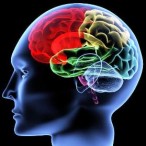
The
most complicated object in the known universe is the human brain. On
average, our brain contains about eleven billion neurons. Each one
working to send, receive and process electrochemical signals. Our
thoughts, emotions, movements and very existence are dependent on
processes within the brain that are still largely a mystery to us. One
may wonder how such a wondrous and complex organ came to be. It is here
that we begin to decipher the effect of evolution on the human brain.
Assuming
the theory of evolution, that organisms more suited to their
environment can survive better and mate, it makes sense that, somehow,
having a larger and more complex brain makes survival on Earth easier.
Indeed, if one were to look at the brain size of our hominid ancestors
from four million years ago, it would be discovered that their brains
were a mere 400 grams. Compare that to the present size- over 1400
grams (1.4kg).
But it
was more than sheer size that changed, but the actual structure of the
brain. What happened earliest was the centralization of the brain’s
nerve cells. What started as a loose and messy grouping of cells that
would be seen in a jellyfish, turned into a spinal column and enlarged
fore- and hindbrain. These parts of the brain that are relatively new
are known as neocortical, literally “new brain”. Actually, things such
as our abilities to speak, plan, and be conscious of our own existence
depend on neocortical structures. This means that when the brain became
more complex, we gained a completely different way to interact with our
world. Language allowed humans to organize themselves and hunt more
effectively- and having a larger and more complex brain allowed a
higher capacity for intelligence, thought, and planning. These are all
things that gave humanity an advantage against predators, prey, and the
world’s wide variety of dangerous natural elements.
The
brain also experienced a phenomenon known as encephalization, which is
the concentration of sense organs and neurons in one part of the body.
This is why the brain, olfactory sense, hearing, and sight are all
housed in the head. This made it easier for the brain to work because
the signals that neurons use wouldn’t have to travel as far if the
brain is all in one place.
Evolution
caused the brain to become larger, more complex, and more efficient.
Much how we make our computers with more space, more speed and
efficiency with every new generation (this excludes Apple, of course).
There is certainly is proof of our brain’s effect on the world. Humans
are definitely a thriving species. One may also consider the worldwide
subjugation and abuse of animals to be proof of our dominance as a
species.
But it
is important to remember that neurology has only scratched the surface
when it comes to the human brain. There are still plenty of things we
don’t know, actually we don’t know most things. There could be
all kinds of secrets within the brain waiting to be unlocked, like other
senses, the power of thought, or ways to become more intelligent
faster. All this would also make one wonder what evolutionary stage the
brain will achieve in another thousand years.
Works Cited:
Brain evolution. (2010). Retrieved from http://www.youramazingbrain.org.uk/insidebrain/brainevolution.htm
Evolution and the brain. (2010). Retrieved from http://www.nature.com/nature/journal/v447/n7146/full/447753a.html
Without miracles 5 brain evolution and development. (2010). Retrieved from http://faculty.ed.uiuc.edu/g-cziko/wm/05.html
